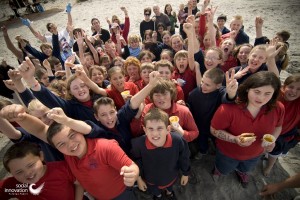Christchurch: The extraordinary emerging community, two years on …
Gap Filler
Reflections on September 4th
by Steve Carter
“The truth is that our finest moments are most likely to occur when we are feeling deeply uncomfortable, unhappy, or unfulfilled. For it is only in such moments, propelled by our discomfort, that we are likely to step out of our ruts and start searching for different ways or truer answers.”
– M.Scott Peck
I didn’t expect to see quite as much of September 4th 2010 as circumstances forced upon me.
It turned out to be one of those beautiful, crisp Christchurch early Spring days: the sunrise illuminating the snow-covered Southern Alps beneath a crystalline blue sky. I love a good sunrise, but I can probably count on the fingers of one hand the number for which I have purposefully risen. When I went to bed on September 3rd it certainly wasn’t my intention to get out of bed at half past four in the morning and drive up into the Port Hills in the freezing cold to flee the perceived threat of a tsunami.
Some things are just beyond our control.
If there is anything that the people of the wider Canterbury region have learned in these toughest two years, it is that we are slave to much that is beyond our control. “Life” it has been said, “is something that happens while you are making other plans.”
However, amidst all of the challenge and change, we have also learned that our responses to circumstances are very much ours to define. As Maya Angelou said, “I can be changed by what happens to me, but I refuse to be reduced by it.”
In reflecting on the anniversary of the start of the whole earthquake sequence, I have found it useful to remind myself of all the good things that have happened, to put gratitude at the forefront of my thinking. That is not to deny the loss, the deaths, the change, the constant disruption. This is a strange and discomfiting city to live in day after bewildering day. Nobody is immune to the ongoing effects of the quakes and some people are still doing it very hard. I don’t wish to dismiss the reality of their lives.
But the joy of writing this column has been the opportunity to connect to a whole range of people enacting the solutions, living the response and the recovery. In many ways, I feel I am only skimming the surface of how people are variously adapting, coping, or even thriving despite the hardest of circumstances … indeed, in many cases precisely because of those trials.
New Brighton
The ‘Hollywood-isation’ of our culture would have it that societies crumble into chaos in the wake of disaster but, if anything, the opposite is frequently proved to be the case. In perfect echo to the sentiments in the M.Scott Peck quote at the head of this article, human beings are often at their finest when life is at its toughest. We discover our deepest selves and our individual strengths and qualities, and we discover each other and the real nature of our connectedness and interdependance.
These opinions are parallel to those expressed by the American writer Rebecca Solnit in her book ‘A Paradise Built in Hell: The Extraordinary Communities That Arise in Disaster’. She writes: “[D]isaster could be called a crash course in Buddhist principles of compassion for all beings, of nonattachment, of abandoning the illusion of one’s sense of separateness, of being fully present, of awareness of ephemerality, and of fearlessness or at least aplomb in the face of uncertainty.”
Again, this is not to underplay the difficult situations that many have found themselves in or to deny the health and social effects that have accrued for many … but the reality is that the expected spike in multiple psycho-social problems has not really eventuated. In this past couple of days, Canterbury University Professor of Psychology Deak Helton stated that cognitive and sleep disruptions suffered by Cantabrians have now ‘kind of petered out’. He says most research indicates that Cantabrians are now more resilient after having dealt with the stress of the earthquakes.
The earthquakes have been a leveller, with everyone effected in some way. The consequent discovery of common purpose and shared aspirations have been instrumental in undermining many of the stereotypes on which Christchurch could be said to have once operated. The ‘New Normal’ will never be the same normal as the one we left behind, much as some might clamour for a return to those old certainties.
Street art: Giraffe, Unknown artist, photo taken in Christchurch by Reuben Woods
Solnit also says that those in charge assume, “We are all easily-activated antisocial bombs waiting to go off”, and that evidence from previous disasters shows a repeating pattern of behaviour from leaders. As she says, “Belief in panic provides a premise for treating the public as a problem to be shut out or controlled by the military.”
A consequence of this phenomenon has been the other extraordinary experience in Canterbury: the new willingness of more communities to take control of their circumstances through collective action and shared voice. There has been wilful resistance to the structures of control and a desire to wrest back the future from agendas and vested-interest positioning. Perhaps this is exactly why it suits some to paint disasters as hotbeds of social disintegration when they are, in fact, often quite the opposite?
Some of the energy for dissent has, of course, been derived from anger and frustration, some possibly from a naïvety regarding the enormity of the task ahead and the best way to manage it. Nevertheless, while the System is turned the other way, busying itself with infrastructure projects such as roads, power, water and sewerage, a quiet revolution has occurred at community level. People are working together to fill this vacuum, to reimagine their spaces, to entertain and support each other … to stand shoulder to shoulder, eyes front to the future.
The real engine of the recovery is undeniably vested in the people of Christchurch and wider Canterbury. It is not a mere economic concern: neither the sole preserve of business owners and property developers, nor something to be written solely by bureaucrats. Politicians and paper-shovers will come and go. The future definition of this city will be the collective result of the actions of all its people.
It is a pleasure to continue play a small part in documenting just some of those actions.
Read the inspiring stories of our Christchurch sponsors:
 SHAC – The Sustainable Habitat Challenge – is a network of architects, builders, engineers, designers, building scientists, students and young professionals interested in taking positive action in their communities today.
SHAC – The Sustainable Habitat Challenge – is a network of architects, builders, engineers, designers, building scientists, students and young professionals interested in taking positive action in their communities today.
On the 2-3 May 2012, SHAC presented the 2nd annual workshop on micro-architecture at the Christchurch Polytechnic Student Centre. Sixty attendees discussed temporary architecture, simple buildings, and the reuse of building material.
“People cherish their culture through recycling” – those are the words of Wang Shu, the 2012 winner of the Pritzker architecture prize. The demolition of red stickered housing and CBD buildings does not have to mean the eradication of Christchurch’s history or culture – nearly all materials can be reused in new construction, incorporating local memories and fusing the past with the present.
What is permanent in this land of earthquakes? In San Francisco, the Palace of Fine Arts was built in 1915 as a temporary building for the Panama-Pacific Exposition and still stands today as an icon of the city. From the cardboard cathedral to the convention centre – how long will they serve us?
“Simple buildings are key for affordability” said Canadian architect Brian McKay Lyons, recently interviewed on Nine to Noon with Kim Hill. Lyons, from Nova Scotia, says “simple buildings are what we farmers and fishermen build when we can’t afford to get things wrong”
This symposium brought together elements of the growing Regeneration movement – people working together to take positive action in their communities.
Community Rebuild – for the Whole House Reuse project Juliet Arnott
Community Development – Joshua Durrant, Jess Smale, Sophie Moore
Positive Action – Gapfiller Trust
 YTONG® is an alternative building system made from light-weight Aerated Autoclaved Concrete (AAC). It was invented in Sweden in 1923 and further developed under the YTONG® brand it turned into a world-wide success.
YTONG® is an alternative building system made from light-weight Aerated Autoclaved Concrete (AAC). It was invented in Sweden in 1923 and further developed under the YTONG® brand it turned into a world-wide success.
Environmentally friendly and non-toxic – From the manufacturing process to shipment, construction, and waste disposal YTONG® is in ecological balance.
Good sound absorption – effective sound barrier – The natural air cushion formed in the high-pressure steam curing of AAC can absorb the most possible noise.
Ensures high standard of well-being – YTONG® reduces temperature differences and humidity fluctuations and so ensures a comfortable and healthy room atmosphere.
Excellent workability – It is easy to erect a solid masonry structure quickly and precisely. Only few tools and implements are necessary.
Outstanding thermal insulation – Keeps buildings cool in summer and warm in winter saving on heating and air-conditioning.
YTONG® is fireproof and has a high fire rating – AAC is resistant to high temperatures for a longer period of time than any other solid building material. YTONG® is especially chosen for fireproof walls in commercial buildings.
Performs well in earthquakes – Thanks to its low weight and its plastic deformation properties the destructive force of earthquakes can be minimised.
 Social Innovation is a small, hardworking community engagement agency based in Christchurch. They work with leading non-profits, changemakers, progressive companies and government to mobilise everyday New Zealanders. Their expertise in this area comes from grassroots innovation on large-scale community action projects, including the Student Volunteer Army, A Day at the Beach Festival, Love your Coast and a number of other public participation initiatives. They know how to scale initiatives and achieve big results with large numbers of stakeholders.
Social Innovation is a small, hardworking community engagement agency based in Christchurch. They work with leading non-profits, changemakers, progressive companies and government to mobilise everyday New Zealanders. Their expertise in this area comes from grassroots innovation on large-scale community action projects, including the Student Volunteer Army, A Day at the Beach Festival, Love your Coast and a number of other public participation initiatives. They know how to scale initiatives and achieve big results with large numbers of stakeholders.
 kiwi folk heroes like Kate Sheppard combined with the sheer power of modern technology. At the heart of what they do is supporting everyday New Zealanders to take action and participate fully in public life, in turn increasing the proportion of citizen’s who know that they can make a difference to the way things are.
kiwi folk heroes like Kate Sheppard combined with the sheer power of modern technology. At the heart of what they do is supporting everyday New Zealanders to take action and participate fully in public life, in turn increasing the proportion of citizen’s who know that they can make a difference to the way things are.Their services include strategy, leadership training, volunteer coordination & management, media and communications, project management and fundraising. Find out more at www.socialinnovation.org.nz or make direct contact via their studio-line on 03 337 0861
Ph: 03 337 0861 or [email protected]
The Local Good News initiative is officially endorsed by Mental Health New Zealand.
Got good news to share about your social enterprise? Join this inspiring line up of Christchurch sponsors, email [email protected]
loading...
loading...
Tags: christchurch





You are doing such an awesome job Steve.
loading...
loading...
I agree with Charlotte. I look forward and love reading your posts Steve, especially since I’ve been away and will continue to be away from home for a few more months. Your stories always bring a smile to my face.
loading...
loading...
I think the fact that you have put such a positive spin on the situation here is a testament to your vision Steve. The divergence between the politics/economics ‘governing’ the situation and the needs of the local community are too bizarre to believe, unless it is with deeply cynical eyes. The Ing building/sports Stadium thng killed it for me – I’m just bored with it all now and plan my escape….. I remember when I first looked at this article, I couldn’t finish it – it was too lovely. I remember being like that once upon a time. Thanks for the heads up that life is about how it’s viewed more than anything…….
loading...
loading...